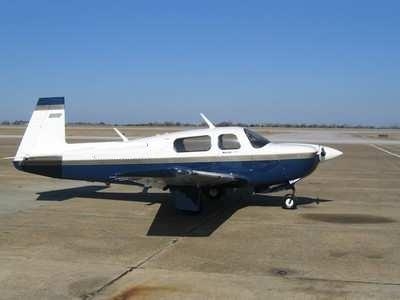Four People Fatally Injured When Mooney Went Down In Wyoming Mountains
Two federal lawsuits against a company that provides contract air traffic control services at Jackson Hole (WY) airport are headed to mediation in an effort to get the suits resolved. The estate of pilot Luke Bucklin of Minnesota and the pilot's ex wife, who is the mother of the three children fatally inured in the accident, are pressing the actions against Serco Inc., in connection with an accident that fatally injured Bucklin and his three sons in 2010.

Bucklin, a Minneapolis businessman, had flown his three sons to Wyoming for a family gathering in his 1977 Mooney M20J (similar airplane pictured. Not accident aircraft). According to the NTSB's probable cause report, the four had planned to fly back to Minnesota on Sunday, October 24, but were delayed by winter weather. He booked a commercial flight, but that was cancelled for non-weather reasons, so he decided to make the flight himself on Monday.
The report indicates that he contacted flight services twice by telephone to obtain weather briefings and filed a flight plan. Both weather briefings included AIRMETs for mountain obscuration, turbulence, and icing along the planned flight route and altitude. About 2 hours after the second call, the pilot filed a second instrument flight rules (IFR) flight plan by computer, with a proposed departure time 10 minutes after the filing time. About 20 minutes after filing, the pilot was issued a clearance that differed from the one he had requested. The differences included a departure to the south instead of the north, an off-airway segment, and a clearance altitude 5,000 feet higher than originally requested. The assigned altitude was lower than and counter to Federal Aviation Administration (FAA) published requirements for the area in which the pilot was flying, but neither the pilot nor the controller questioned the altitude assignment. The airplane departed 8 minutes after the clearance was
issued.
About 30 minutes after takeoff, when the airplane was on the off-airway segment, radar coverage from the Rock Springs Air Route Surveillance Radar was lost because the system at the FAA facility that was handling the airplane was intentionally made unavailable to controllers due to data reliability concerns. However, controllers at another FAA facility that was not handling the airplane continued to successfully use that same data. Four minutes later, the pilot filed a report with flight services that he was encountering light turbulence and a trace of rime icing. About 6 minutes later, the airplane was reacquired by ground radar. The controller then asked the pilot to climb to 16,000 feet, the minimum IFR altitude in that sector. Two minutes later, the pilot reported that he might not be able to reach 16,000 feet. About 2 minutes after that, the pilot reported that he was in a "severe mountain wave," and that he was "descending rapidly." There were no further communications from or radar targets
associated with the airplane. The wreckage was located 7 days later, at an elevation of about 11,000 feet. Damage patterns were consistent with impact while the airplane was in a left spin. Examination of the engine and airframe did not reveal any preexisting mechanical deficiencies or failures that would have precluded normal operation.

The NTSB found that the probable cause of the accident was the pilot's decision to fly in "known adverse weather conditions over mountainous terrain, which required operation near the limits of the airplane's performance capability and which resulted in a loss of airplane control and subsequent ground impact. But the board added that "an improper clearance issued by the air traffic controller and the pilot's acceptance of that clearance. Also contributing to the accident was the extended loss of radar data from the Rock Springs Air Route Surveillance Radar, which caused loss of radar contact and consequent loss of minimum safe altitude warning protection for the flight."
The Associated Press reports that both lawsuits place responsibility for the accident on the shoulders of Serco for issuing an improper clearance for the flight. The attorneys for Bucklin's estate and the ATC company have notified U.S. District Judge Alan B. Johnson of Cheyenne, WY, last week that the case involving the children would be mediated in Minneapolis this week, while the other case would be heard next month.
The federal government is not specifically named as a defendant in the suit, but it has agreed to be part of the meditation process with its contractor.
 ANN's Daily Aero-Linx (04.13.24)
ANN's Daily Aero-Linx (04.13.24) ANN's Daily Aero-Term (04.13.24): Beyond Visual Line Of Sight (BVLOS)
ANN's Daily Aero-Term (04.13.24): Beyond Visual Line Of Sight (BVLOS) Airborne 04.09.24: SnF24!, Piper-DeltaHawk!, Fisher Update, Junkers
Airborne 04.09.24: SnF24!, Piper-DeltaHawk!, Fisher Update, Junkers Aero-News: Quote of the Day (04.14.24)
Aero-News: Quote of the Day (04.14.24) ANN's Daily Aero-Term (04.14.24): Maximum Authorized Altitude
ANN's Daily Aero-Term (04.14.24): Maximum Authorized Altitude




